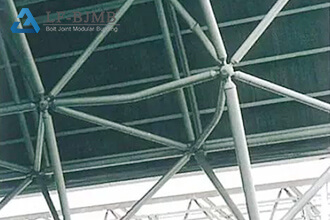+86 177 5193 6871
222, Block B, Diamond International, Guozhuang Road, Xuzhou, Jiangsu, China
In earthquake-prone areas, the design of steel buildings requires several effective measures to minimize earthquake-induced injuries. The following are some common design principles and recommendations:

Elastic Design: Elastic design principles are used to allow the structure to deform to some extent without losing stability during an earthquake. This helps mitigate earthquake-induced shocks and stresses and reduces the likelihood of structural damage.
Use of Seismic Design Codes: Follow national or regional seismic design codes and standards, which often include guidance on seismic load calculations, structural seismic design principles, and selection of building materials.
Reducing structural mass: Reducing the deadweight of a structure reduces the inertial forces caused by earthquakes, which in turn reduces the seismic response of the structure. Lightweight structures are generally more adaptable to seismic actions.
Use flexible lateral systems: Use flexible lateral systems such as shear walls, frames, and cores to better absorb and distribute earthquake-induced energy.
Setting Interstory Displacement Control Limits: Reduce the seismic damage to the structure by setting interstory displacement limits to control the deformation of the structure. This can be achieved through the proper design of inter-story stiffness.
Prevent Lateral Torsion: Adopt appropriate design measures to inhibit lateral torsion of the structure and reduce the torsional effects caused by earthquakes. This can be achieved by installing rigid connections or reinforcing the lateral system of the structure.
Provision of Safe Exits and Evacuation Spaces: Consider the safety of people in the design and provide appropriate safe exits and evacuation spaces to ensure that people can evacuate quickly or find a safe place to evacuate in the event of an earthquake.
Use of energy-dissipating devices: Introduce energy-dissipating devices such as dampers or vibration absorbers into the structure to absorb seismic energy and reduce the magnitude of vibrations in the structure.
Regular Maintenance and Inspection: Regular maintenance and inspection of the structure should be carried out to ensure that the seismic performance of the structure can be maintained in the long term. Damaged parts should be repaired or replaced promptly.
These measures need to be comprehensively considered by professional structural engineers according to specific engineering requirements and seismic conditions and follow local seismic design codes. Earthquake protection engineering is a complex field that requires specialized knowledge and experienced engineers to design and implement.
